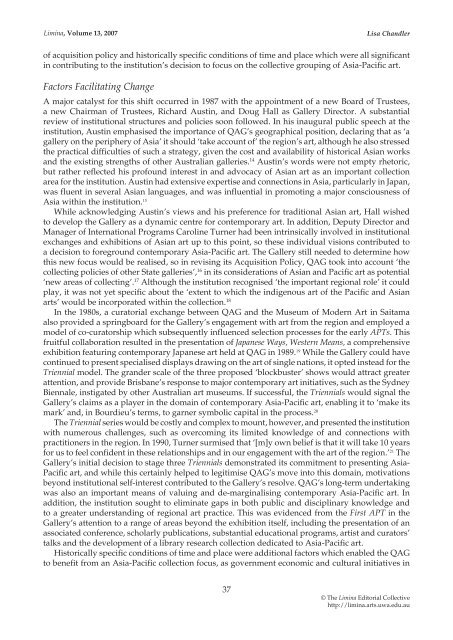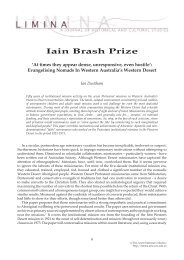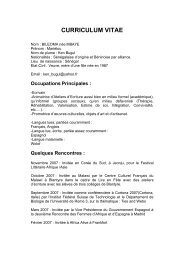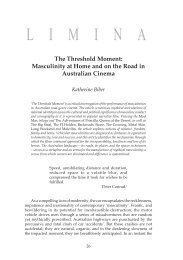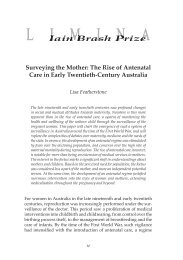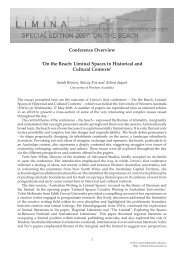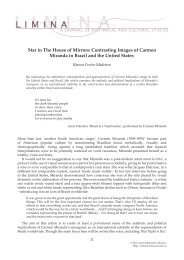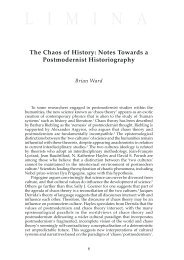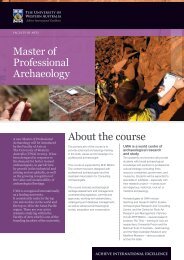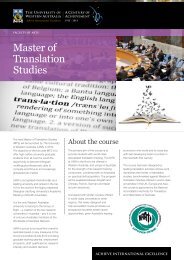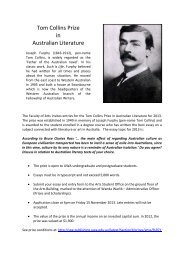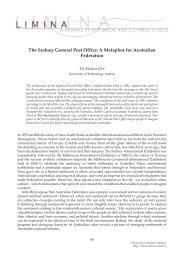'The Asia-Pacific Effect': Geo-Cultural Grouping at the ... - Past volumes
'The Asia-Pacific Effect': Geo-Cultural Grouping at the ... - Past volumes
'The Asia-Pacific Effect': Geo-Cultural Grouping at the ... - Past volumes
Create successful ePaper yourself
Turn your PDF publications into a flip-book with our unique Google optimized e-Paper software.
Limina, Volume 13, 2007<br />
Lisa Chandler<br />
of acquisition policy and historically specific conditions of time and place which were all significant<br />
in contributing to <strong>the</strong> institution’s decision to focus on <strong>the</strong> collective grouping of <strong>Asia</strong>-<strong>Pacific</strong> art.<br />
Factors Facilit<strong>at</strong>ing Change<br />
A major c<strong>at</strong>alyst for this shift occurred in 1987 with <strong>the</strong> appointment of a new Board of Trustees,<br />
a new Chairman of Trustees, Richard Austin, and Doug Hall as Gallery Director. A substantial<br />
review of institutional structures and policies soon followed. In his inaugural public speech <strong>at</strong> <strong>the</strong><br />
institution, Austin emphasised <strong>the</strong> importance of QAG’s geographical position, declaring th<strong>at</strong> as ‘a<br />
gallery on <strong>the</strong> periphery of <strong>Asia</strong>’ it should ‘take account of’ <strong>the</strong> region’s art, although he also stressed<br />
<strong>the</strong> practical difficulties of such a str<strong>at</strong>egy, given <strong>the</strong> cost and availability of historical <strong>Asia</strong>n works<br />
and <strong>the</strong> existing strengths of o<strong>the</strong>r Australian galleries. 14 Austin’s words were not empty rhetoric,<br />
but r<strong>at</strong>her reflected his profound interest in and advocacy of <strong>Asia</strong>n art as an important collection<br />
area for <strong>the</strong> institution. Austin had extensive expertise and connections in <strong>Asia</strong>, particularly in Japan,<br />
was fluent in several <strong>Asia</strong>n languages, and was influential in promoting a major consciousness of<br />
<strong>Asia</strong> within <strong>the</strong> institution. 15<br />
While acknowledging Austin’s views and his preference for traditional <strong>Asia</strong>n art, Hall wished<br />
to develop <strong>the</strong> Gallery as a dynamic centre for contemporary art. In addition, Deputy Director and<br />
Manager of Intern<strong>at</strong>ional Programs Caroline Turner had been intrinsically involved in institutional<br />
exchanges and exhibitions of <strong>Asia</strong>n art up to this point, so <strong>the</strong>se individual visions contributed to<br />
a decision to foreground contemporary <strong>Asia</strong>-<strong>Pacific</strong> art. The Gallery still needed to determine how<br />
this new focus would be realised, so in revising its Acquisition Policy, QAG took into account ‘<strong>the</strong><br />
collecting policies of o<strong>the</strong>r St<strong>at</strong>e galleries’, 16 in its consider<strong>at</strong>ions of <strong>Asia</strong>n and <strong>Pacific</strong> art as potential<br />
‘new areas of collecting’. 17 Although <strong>the</strong> institution recognised ‘<strong>the</strong> important regional role’ it could<br />
play, it was not yet specific about <strong>the</strong> ‘extent to which <strong>the</strong> indigenous art of <strong>the</strong> <strong>Pacific</strong> and <strong>Asia</strong>n<br />
arts’ would be incorpor<strong>at</strong>ed within <strong>the</strong> collection. 18<br />
In <strong>the</strong> 1980s, a cur<strong>at</strong>orial exchange between QAG and <strong>the</strong> Museum of Modern Art in Saitama<br />
also provided a springboard for <strong>the</strong> Gallery’s engagement with art from <strong>the</strong> region and employed a<br />
model of co-cur<strong>at</strong>orship which subsequently influenced selection processes for <strong>the</strong> early APTs. This<br />
fruitful collabor<strong>at</strong>ion resulted in <strong>the</strong> present<strong>at</strong>ion of Japanese Ways, Western Means, a comprehensive<br />
exhibition fe<strong>at</strong>uring contemporary Japanese art held <strong>at</strong> QAG in 1989. 19 While <strong>the</strong> Gallery could have<br />
continued to present specialised displays drawing on <strong>the</strong> art of single n<strong>at</strong>ions, it opted instead for <strong>the</strong><br />
Triennial model. The grander scale of <strong>the</strong> three proposed ‘blockbuster’ shows would <strong>at</strong>tract gre<strong>at</strong>er<br />
<strong>at</strong>tention, and provide Brisbane’s response to major contemporary art initi<strong>at</strong>ives, such as <strong>the</strong> Sydney<br />
Biennale, instig<strong>at</strong>ed by o<strong>the</strong>r Australian art museums. If successful, <strong>the</strong> Triennials would signal <strong>the</strong><br />
Gallery’s claims as a player in <strong>the</strong> domain of contemporary <strong>Asia</strong>-<strong>Pacific</strong> art, enabling it to ‘make its<br />
mark’ and, in Bourdieu’s terms, to garner symbolic capital in <strong>the</strong> process. 20<br />
The Triennial series would be costly and complex to mount, however, and presented <strong>the</strong> institution<br />
with numerous challenges, such as overcoming its limited knowledge of and connections with<br />
practitioners in <strong>the</strong> region. In 1990, Turner surmised th<strong>at</strong> ‘[m]y own belief is th<strong>at</strong> it will take 10 years<br />
for us to feel confident in <strong>the</strong>se rel<strong>at</strong>ionships and in our engagement with <strong>the</strong> art of <strong>the</strong> region.’ 21 The<br />
Gallery’s initial decision to stage three Triennials demonstr<strong>at</strong>ed its commitment to presenting <strong>Asia</strong>-<br />
<strong>Pacific</strong> art, and while this certainly helped to legitimise QAG’s move into this domain, motiv<strong>at</strong>ions<br />
beyond institutional self-interest contributed to <strong>the</strong> Gallery’s resolve. QAG’s long-term undertaking<br />
was also an important means of valuing and de-marginalising contemporary <strong>Asia</strong>-<strong>Pacific</strong> art. In<br />
addition, <strong>the</strong> institution sought to elimin<strong>at</strong>e gaps in both public and disciplinary knowledge and<br />
to a gre<strong>at</strong>er understanding of regional art practice. This was evidenced from <strong>the</strong> First APT in <strong>the</strong><br />
Gallery’s <strong>at</strong>tention to a range of areas beyond <strong>the</strong> exhibition itself, including <strong>the</strong> present<strong>at</strong>ion of an<br />
associ<strong>at</strong>ed conference, scholarly public<strong>at</strong>ions, substantial educ<strong>at</strong>ional programs, artist and cur<strong>at</strong>ors’<br />
talks and <strong>the</strong> development of a library research collection dedic<strong>at</strong>ed to <strong>Asia</strong>-<strong>Pacific</strong> art.<br />
Historically specific conditions of time and place were additional factors which enabled <strong>the</strong> QAG<br />
to benefit from an <strong>Asia</strong>-<strong>Pacific</strong> collection focus, as government economic and cultural initi<strong>at</strong>ives in<br />
37<br />
© The Limina Editorial Collective<br />
http://limina.arts.uwa.edu.au


